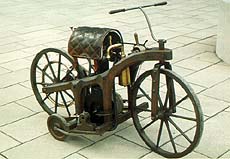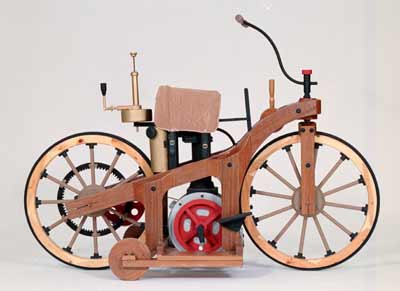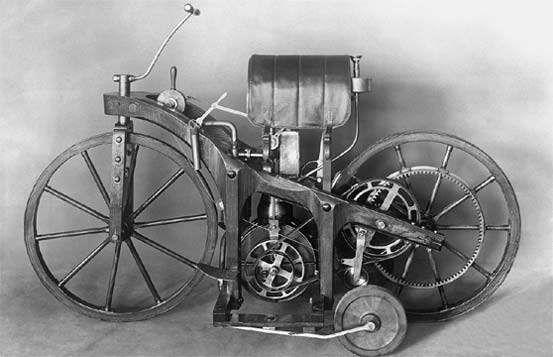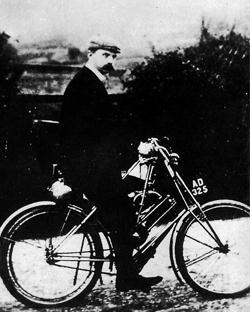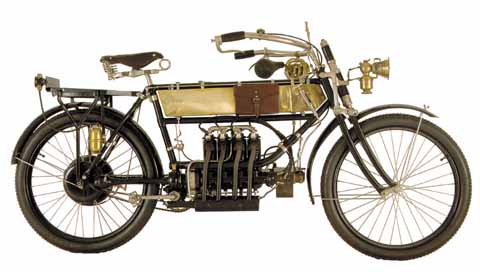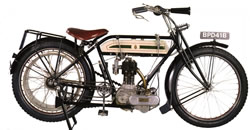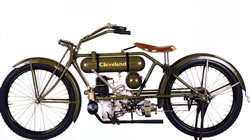The First Motorcycle
By Steve
Copyrighted 1999
|
"Who
invented the first motorcycle?" This is a simple question, but the answer
becomes more complicated than that simply being asked or requested,
as its buried in the sands of time........
Intro ..... The bicycle is an invention of the 19th century. It is not a result of scientific considerations, but of trial and error. Over 90 years, from 1810 to 1890 were needed for the bicycle to develop from the 'hobbyhorse' to the velocipede and high-wheeler to the safety bicycle. Motorcycles are descended from bicycles, which naturally had motors placed in a variety of ways to save having to pedal. The first 'handling' bikes looked a bit like this ........ |
||||||
| 1816 | ||
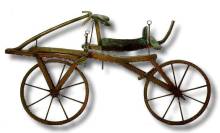 |
The first single-track two-wheeled vehicles were "wooden horses" known as célérifères and vélocifères. The rider pushed his feet backward against the ground, not only to propel the vehicle forward, but also to help him maintain his balance. In 1816, Baron Karl von Drais, a German, invented a model with a guide handle connected to the front wheel. The draisienne, was less a serious mode of transportation than the folly of a wealthy nobleman. Still, it remains one in a long line of inventions that led to the true bicycle. This type of steering enabled the rider to keep his balance without necessarily having to touch the ground. | |
|
Draisienne, 1816
One of the oldest two-wheeled hobby horses |
|
|
| So it all began about 130 years ago ............ | ||
| 1867 / 68 | ||
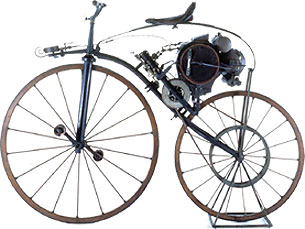 |
|
Michaux - Perreaux Steam Velocipede seems to have been the known "first". It was created around 1868 - 1871 in France. Bore and Stroke 58x100mm. Top speed was reputed to be a staggering 20 mph Cool looking machine ..... |
| 1867 | ||
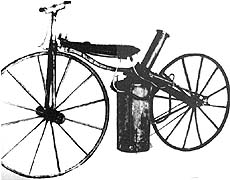 S. Roper's circa 1867 Steam-cycle |
|
Steam propulsion? for a motorcycle?, is this a motorbike? if so then the first one may will have been an American invention. One such machine was demonstrated at fairs and circuses in the eastern US in around 1867. It was built by Sylvester Howard Roper of Roxbury, Massachusetts. There is an example of a Roper machine, dated 1869. It's powered by a charcoal-fired two-cylinder engine, whose connecting rods directly drive a crank on the rear wheel. This machine predates the invention of the safety bicycle by many years, so its chassis is a "bone-crusher" non-springed type. Thick protective pants would have been the go on this umm machine ..... |
| 1885 | ||
|
|
|
Gottlieb Daimler is however largely credited with building the first motorcycle in around 1885, wheels front back, but had a smaller spring-loaded outrigger stabiliser wheel on each side. It was constructed mostly of wood, with the wheels being iron-banded wooden-spoked.
It was powered by a single-cylinder 264cc Otto-cycle engine, and possibly a spray-type carburetor. (Daimler's assistant, Wilhelm Maybach was working on the invention of the spray carburetor around this time). Power Output 0.5hp @ 600rpm Daimler’s son Paul became the "first motorcyclist" on November 10, 1885, when he rode his father’s invention for nearly 10 km (6 mi). Top Speed 7mph or so. |
| 1892 | ||
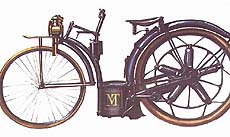 The 1892 5-cylinder Millet |
|
Next really was the Millet of 1892. It used a 5-cylinder engine built as the hub of its rear wheel. The cylinders rotated with the wheel, and its crankshaft constituted the rear axle. |
| 1894 | ||
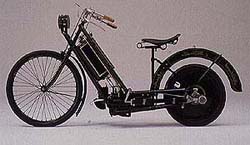 |
The first known
production of a two-wheeler was the Hildebrand & Wolfmueller. This
was patented in Munich in 1894. Sporting a step-through frame, with
frame mounted fuel tank on the downtube. The connecting rods connected directly to a crank on the rear axle, and used a pair of stout elastic bands, one on each side outboard of the cylinders. Top Speed was 24mph with a 12 hour endurance from one tank of fuel. watch one running
here |
|
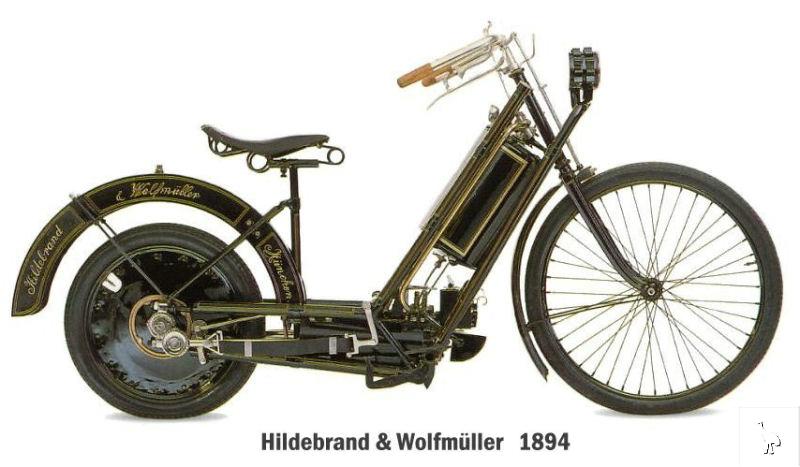
|
||
| 1895 | ||
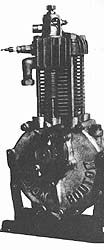 The DeDion - Buton |
|
The French firm of DeDion-Buton built an engine that was to make the mass production and common use of motorcycles possible. It was a small, light, high revving four-stroke single, and used battery-and-coil ignition, doing away with the troublesome hot-tube. Bore and stroke figures of 50mm by 70mm gave a displacement of 138cc. A total loss lubrication system was employed to drip oil into the crankcase through a metering valve, which then sloshed around to lubricate and cool components before dumping it on the ground via a breather. DeDion-Buton used this 1/2 horsepower powerplant in roadgoing trikes, but the engine was copied and used by everybody, including Indian and Harley-Davidson in the U.S. |
| 1897 - Leon Bollee 1897 | Leon Bollee utube video | |
| 1898 | ||
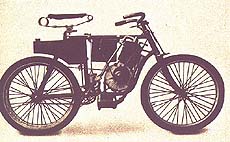 The 1898 First USA production motorcycle - Orient-Aster |
|
The first USA production motorcycle was the Orient-Aster, built by the Metz Company in Waltham, Massachusetts. It used an Aster engine which was a French-built copy of the DeDion-Buton. It predated the Indian (1901) by three years, and Harley-Davidson (1902) by four. |
| 1903 | ||
|
Anders Mellerup on a Pedersen motor cycle, about 1903 source of photo |
Mikael Pedersen invented a motor cycle. He used a frame from the bike and in this he put a Single cylinder Joe Barter engine. Only a few machines were sold. There is however an avid collector group out there |
|
| 1904 | TTMotor racing first came to the Isle of Man, as it was impossible to close public roads in England. The first TT races were held in 1907. | |
| 1910 | ||
|
|
1910 FN The Belgian arms company FN was the first to make a 4-cylinder motorcycle. It even had shaft drive |
|
| 1914 | ||
|
1914 example - Triumhp Tourist Trophy, Type G - click
for a larger pic
|
|
Manufactured specifically for the dirt track at IOM, this bike was a single cylinder, 4 horsepower, 4 stroke engine of 550cc with a 3 speed transmission. It featured adjustable tappets and a side by side valve placement It used an Aster engine that was a French-built copy of the DeDion-Buton, and predated the Indian (1901) by three years, and Harley-Davidson (1902) by four. |
|
1918 |
||
|
The Cleveland Motorcycle Company built a 2 stroke lightweight - almost an exact copy of Triumph's Junior model. It continued production until 1924. It had a coil producing spark, a two speed lever hand operated transmission and could reach a speed of 45mph |
||
